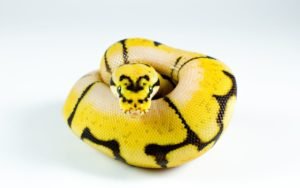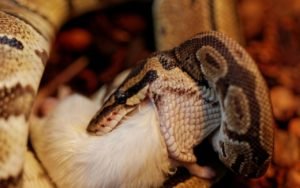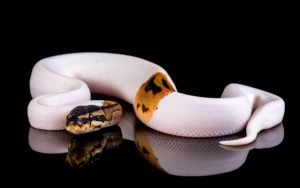Deciding to assist feed a baby Ball Python should always be a last resort. In some cases, though, it could save their life. Let’s find out when…
If you have a hatchling Ball Python that has never eaten, and four weeks have gone by, it is probably time to assist feed. Likewise, any baby under three months old should be assist fed if it is showing signs of severe malnourishment. For older animals, consult an exotics veterinarian.
Look for the following signs of severe malnourishment to help you decide:
- Loss of girth around the neck
- Loss of fat on sides of head
- Protruding spine, giving its body a “triangle” shape
- Lethargy (sluggishness)
- Severe shaking: Not just a slight tremor like some babies get
How to assist feed a baby Ball Python
Assist feeding a baby Ball Python is a nerve-racking experience. Not least because manhandling a cute baby animal goes against all of our instincts as pet keepers. That said, some baby Ball Pythons just will not eat. For these individuals, assist feeding will be necessary.
To make sure we you do it correctly, you must approach assist feeding in a calm, confident, and informed manner. Do your homework first, then – if it’s really necessary – get it done!
As with many handling techniques, I could write out detailed instructions all day long, but they still wouldn’t explain the process as well as a good demonstration. With that in mind, start by checking out the following YouTube video by a fellow breeder. The person in this video uses the exact same technique as me and clearly cares about the animals.
Afterwards, we’ll discuss the signs your baby Ball Python needs assist feeding, why it isn’t eating, what it should be eating, and what kind of feeding schedule it should be on.
How to prevent injury when assist feeding a Baby Ball Python
The most important thing to get right when assist feeding a baby Ball Python is the placement of your fingers. As in the video above, always place your fingers behind the jaws, on either side of the head.
By holding the snake in this way, you take advantage of its anatomy: When the snake tries to pull back, it helps force it’s jaws open.
This finger placement also prevents injury. Other parts of a Ball Pythons anatomy are too delicate to suffer a similar amount of force. In fact, the glottis, trachea, and gums are all prone to infection from trauma. Avoid ever placing pressure on these structures by respecting the finger placement we’ve described!
If, for example, you hold the snake by applying pressure to the top and underneath of the head instead of the sides, you directly affect these delicate tissues. Enough top-to-bottom pressure crushes them, leading to inflammation and the possibility of infection.
I know you’ve seen some of your favourite TV wildlife personalities holding big Boas like that but trust me – some of those snakes will die from infection in the weeks following their televised beating!

Force feeding vs assist feeding
At this point, it’s important to make the distinction between assist feeding and force feeding. Assist feeding is safer and much less invasive. In fact, assist feeding is a widely used technique for baby Ball Pythons that refuse to eat.
When you assist feed a baby snake, what you’re doing is sticking something into its mouth. If it’s a small prey item, the snake can’t get it out: Its only logical solution to the problem is to swallow it!
For its part, assist feeding looks brutal, but it really isn’t dangerous if done right. Force feeding is a different case altogether. When you force feed a snake you push a prey item all the way into its gullet, then massage it down and into the stomach. This is a much more intensive and dangerous procedure!
Assist feeding vs force feeding comparison table
| Assist feeding | Force feeding |
| Low to medium risk | High risk |
| Done at home | Done under veterinary advice |
| Highly stressful | Extremely stressful |
| Food introduced to mouth | Food forced into aesophagus |
| Only appropriate for baby snakes | Only appropriate for severely ill snakes |
Is force feeding a snake bad?
Force feeding is a procedure used by veterinarians and very experienced reptile hobbyists. It is only ever used when all other options are off the table. It is always a last resort and only appropriate for severely weakened or injured animals, such as those recovering from a systemic infection, for example.
Despite its obvious veterinary usage, force feeding a snake is bad when it is done unnecessarily. If you had an adult Ball Python that hadn’t eaten in five months but showed no signs of illness, force feeding would be a very bad idea indeed. An animal such as this could simply be fasting, and the risk of infection and severe stress from force feeding could actually push it into illness rather than help it.
My advice is to completely forget about force feeding if you are an average, everyday reptile keeper. If you ever have an animal that is so sick or malnourished that it could need force feeding, then you should be taking it to a vet.
For adult snakes especially, you should never force feed or assist feed without first seeing a specialist exotics vet. For baby snakes, you should only assist feed if they appear otherwise healthy, ie have no signs of a respiratory infection, for example. If not, they too will need to see a vet. Attempting to force feed very small snakes can quite simply kill them.

Baby Ball Python not eating
If your new baby Ball Python isn’t eating, it may be completely normal – for a time. A lot of these snakes will go into a sulk for a couple of weeks when you first bring them home. The car ride home, a new enclosure and new humans can be a lot for this shy species to take in.
The best way to get them feeding is to provide small, secure hiding places for them and make sure the temperature and humidity are perfect.
All-in-all, the absolute worst thing you can do for a baby Ball Python has put it into an enclosure that is too large. If you’ve put yours in a 3ft (90cm) vivarium, you probably have your answer right there! Move it into a small tub enclosure, wait a week, and it might surprise you how hungry it becomes.
Another classic error that can stop babies from eating is placing them in a separate tub to feed. For some reason, some pet stores and online resources are still telling people to do this. It is absolutely not a good idea!
When you pick the baby up and put it into a different tub, it loses the confidence of being on its home turf. The result is that often they simply won’t eat.
If you bred and hatched a clutch of python eggs yourself, then you need to be aware that some baby Ball Pythons will refuse to start eating on their own. This is the case where assist feeding is necessary.
The truth is, Ball Pythons are famous for fasting because it’s their go-to response to stress. If you never want to deal with this, I suggest looking at a Boa Constrictor, Rosy Boa or Rainbow Boa instead!
How long can a baby Ball Python go without eating?
How long baby snakes can go without eating varies depending on their weight. Chunky, three-month-old baby Ball Pythons could probably go a few months before dying. Very small hatchlings, on the other hand, could die after six weeks. Moreover, just three weeks without food would (temporarily) stunt their growth.

How to feed a baby Ball Python frozen mice
I often start baby Ball Pythons on frozen-thawed mice because they like them. It really is that simple. Generally, I give them frozen thawed hoppers as their first meal, and the fur makes the snake more interested. After a few weeks, I switch them to rat chubs if they are big enough to handle them.
Maybe these snakes like to tackle mobile prey of a certain age for their first meal, so prefer a fluffy mouse hopper to a naked rat pup? Who knows! I just like to get them eating as soon as possible and about seven out of ten of my babies prefer mice.
If you decide to feed your Ball Python mice, there are a couple of things to consider. First off, feeding live is illegal in some places and not worth the risk anyway, frozen is your best bet.
Second, you need to make sure the mice are properly thawed out and warm before feeding. I do this by getting the mice out and placing them in warm water, inside a sealed plastic bag, for an hour.
Afterwards, I squeeze them to make sure they have thawed all the way through (yes, it’s disgusting), then put them back into water at around 40-45c (104-113f) for another ten minutes.
When assist feeding, you should prepare the mice in the same way. Occasionally, the warmth triggers a feeding response, and they suddenly chomp down once you put the mouse in their mouth.

Baby Ball Python feeding schedule
As a general rule, baby Ball Pythons need feeding every five days for the first few months of their lives. To get more detail on this, check out my “How often should ball pythons eat” article. You will be able to see a feeding frequency table for Ball Pythons of various ages.
The captive Ball Python diet is quite rich when compared to wild snakes, which is why they don’t need vitamin supplements when fed healthy rodents. A lot of resources tell us that captive bred rodents are less nutrient dense than a varied wild diet, which can be true. The bigger picture, however, is that wild snakes generally have a high parasite load. This means that they undoubtedly get much less nutrients from their prey than a captive snake on an all-rat diet!
Despite this rich diet and easy lifestyle, it is important to feed babies often enough because of their faster metabolisms. Once they’ve packed on some weight for a few months, you can then go to feeding them every 7 days instead.
Can you overfeed a baby Ball Python?
It’s a great feeling when you go through the process of assist feeding a hatchling snake and it finally starts to feed. Notwithstanding, it’s important that you do not give in to the temptation to spoil it.
Some babies that are assist fed make a complete turnaround. They go from refusing everything to begging for food at all hours. If you have a baby like this, it’s ok to give it two meals in the first five days after it starts feeding but bring it down to once every five days after that.
If you do overfeed a baby Ball Python the most common result is constipation. Constipation leads to a lot of discomfort and stress, which can lead to the animal refusing to eat again.
Also on this topic:
- What is the best way to feed a Ball Python?
- Do Ball Pythons Need Vitamin Supplements?
- Ball Python not eating (what should I do?)
- Ball Python pit organs
For more on Ball Python diet in general:
Back to the Ball Python diet page
